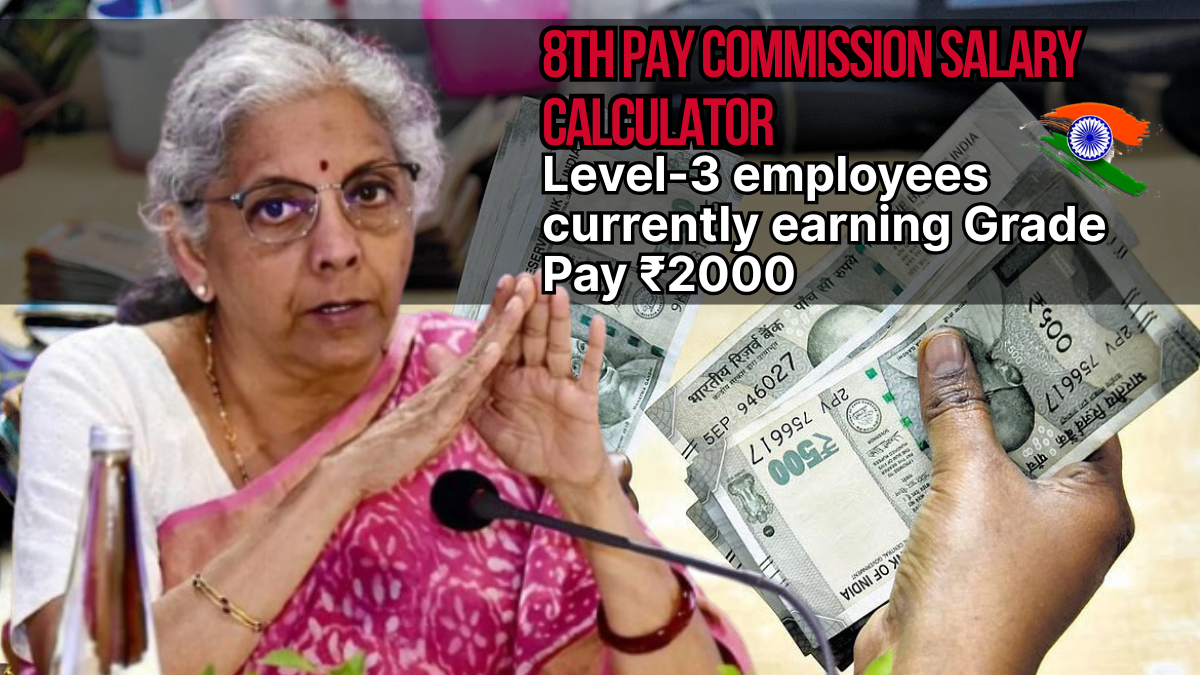Central government employees across India are eagerly anticipating the implementation of the 8th Central Pay Commission (8th CPC), which promises to bring significant changes to their compensation packages. With preliminary calculations suggesting substantial salary increases, particularly for Level-3 employees currently earning Grade Pay ₹2000, understanding these projections becomes crucial for financial planning.
The 8th Pay Commission represents more than just a routine salary adjustment it’s a comprehensive restructuring that could transform the take-home pay for millions of government workers. Based on early estimates using various fitment factors, employees can expect meaningful improvements in their monthly earnings, with some projections showing nearly doubled basic pay amounts.

While official recommendations remain pending, the mathematical possibilities paint an encouraging picture. Using conservative estimates with a fitment factor of 1.92, Level-3 employees could see their basic pay jump from ₹21,700 to ₹41,664 monthly, creating a cascading effect that enhances all salary components.
Understanding the 8th CPC Fitment Factor
The fitment factor serves as the cornerstone of any pay commission revision, acting as the multiplier that determines basic pay increases. This single number influences every aspect of salary calculation, from allowances to deductions, making it the most critical element in projection calculations.
For the 8th CPC, various estimates suggest fitment factors ranging from 1.92 to 2.57. Each scenario produces dramatically different outcomes for government employees. A conservative approach using 1.92 still yields impressive results, while higher factors could lead to unprecedented salary jumps.
The 7th Pay Commission used a fitment factor of 2.57, which increased the minimum salary from ₹7,000 to ₹18,000. However, economic conditions and fiscal constraints may influence the 8th CPC’s final decision, potentially resulting in a more moderate but still substantial increase.
How Different Fitment Factors Impact Level-3 Salaries
Current Level-3 employees earning ₹21,700 in basic pay can expect varying outcomes based on the final fitment factor:
At 1.92 Fitment Factor:
- New Basic Pay: ₹41,664
- Approximate increase: 92%
At 2.08 Fitment Factor:
- New Basic Pay: ₹45,136
- Approximate increase: 108%
At 2.57 Fitment Factor:
- New Basic Pay: ₹55,769
- Approximate increase: 157%
These calculations demonstrate how the fitment factor directly translates into concrete financial benefits for employees.
Complete Salary Breakdown Under 8th CPC Projections
Level-3 Employee Salary Components (Using 1.92 Fitment Factor)
Current 7th CPC Structure:
- Basic Pay: ₹21,700
- Various allowances based on existing rates
- Standard deductions
Projected 8th CPC Structure:
- Revised Basic Pay: ₹41,664
- House Rent Allowance (30% for X-category cities): ₹12,499
- Travel Allowance: ₹3,600
- Gross Salary: ₹57,763
Deductions:
- National Pension System (10%): ₹4,166
- Central Government Health Scheme: ₹250
- Net Take-Home Salary: ₹53,347
This represents a significant improvement from current net salaries, providing government employees with enhanced purchasing power and financial security.
Why House Rent Allowance Could See Major Changes
HRA calculations depend heavily on basic pay amounts and city categories. Under the 8th CPC, even if HRA percentages adjust downward from current rates, the absolute amounts will likely increase due to higher basic pay.
Current speculation suggests HRA might adjust from 30% to 24% for metro cities. However, even with this reduction:
- Current HRA (30% of ₹21,700): ₹6,510
- Projected HRA (24% of ₹41,664): ₹9,999
This calculation shows that employees would still benefit substantially despite percentage reductions.
Dearness Allowance Reset: Understanding the Logic

A common concern among government employees involves Dearness Allowance (DA) under the new pay structure. The 8th CPC will reset DA to zero because existing DA gets merged into the revised basic pay calculation.
This merger prevents double-counting of inflation adjustments already incorporated into the new basic pay structure. Employees don’t lose their existing DA benefits instead, these get absorbed into the higher basic pay, creating a stronger foundation for future DA increases.
Future DA calculations will then apply to the revised basic pay amount, starting fresh from zero. This approach ensures long-term benefits while maintaining fiscal responsibility.
Projected Salary Ranges for Different Pay Levels
Level-1 to Level-5 Projections (1.92 Fitment Factor)
|
Pay Level |
Current Basic Pay |
Projected Basic Pay |
Estimated Net Salary |
|---|---|---|---|
|
Level 1 |
₹18,000 |
₹34,560 |
₹45,000-48,000 |
|
Level 2 |
₹19,900 |
₹38,208 |
₹49,000-52,000 |
|
Level 3 |
₹21,700 |
₹41,664 |
₹53,000-56,000 |
|
Level 4 |
₹25,500 |
₹48,960 |
₹62,000-66,000 |
|
Level 5 |
₹29,200 |
₹56,064 |
₹71,000-76,000 |
These projections include estimated HRA, Travel Allowance, and account for standard deductions like NPS and CGHS contributions.
Senior Level Projections: Where Big Jumps Happen
Higher-level employees stand to gain even more dramatically from the 8th CPC implementation. Level 14-18 employees could see their basic salaries cross ₹3 lakh monthly:
Level 18 Employee (Current Basic Pay ₹2,50,000):
- At 1.92 Fitment Factor: ₹4,80,000
- At 2.57 Fitment Factor: ₹6,42,500
These substantial increases reflect the multiplicative effect of higher fitment factors on already elevated base salaries.
Factors That Could Influence Final Implementation
Government Fiscal Considerations
The final fitment factor depends heavily on the government’s fiscal capacity and overall economic conditions. Higher fitment factors require greater financial commitment from the government, potentially affecting implementation timelines and scope.
Budget allocations, inflation rates, and economic growth projections all influence the commission’s recommendations. The government must balance employee welfare with fiscal responsibility.
Comparison with Previous Pay Commissions
Historical patterns suggest significant increases with each pay commission, but the exact magnitude varies based on contemporary economic realities. The 6th CPC provided a 1.86 fitment factor, while the 7th CPC offered 2.57.
The 8th CPC’s recommendations will consider current inflation levels, cost of living changes, and comparative salary structures in the private sector.
Planning for 8th CPC Implementation
Financial Preparation Strategies
Government employees should prepare for potential changes by:
Budgeting for Higher Income:
- Review current expenses and financial commitments
- Plan for increased tax obligations on higher salaries
- Consider investment opportunities with additional income
Managing Implementation Delays:
- Prepare for potential delays in government approval
- Maintain realistic expectations about implementation timelines
- Budget for potential arrears payments once implemented
Long-term Financial Planning:
- Use projected increases for retirement planning
- Consider property investments with improved financial capacity
- Evaluate insurance needs based on higher income levels
Timeline Expectations and Arrears
Pay commission implementations typically require time for government approval, system updates, and administrative processing. Historical patterns suggest 12-24 months between recommendations and full implementation.
However, once implemented, employees typically receive arrears covering the gap period, providing substantial lump-sum benefits. These arrears can significantly boost short-term financial capacity.
Frequently Asked Questions
Q. Will all government employees benefit equally?
A. Different pay levels will experience varying percentage increases. Lower-level employees often receive proportionally higher benefits, while senior positions may see different adjustment patterns based on market comparisons and fiscal constraints.
Q. How will pension calculations change?
A. Pension calculations typically incorporate revised basic pay structures, potentially increasing future pension amounts for retiring employees. Current pensioners may also benefit from revised pension calculations based on the new pay matrix.
Q. Do state government employees get similar benefits?
A. Central Pay Commission recommendations primarily apply to central government employees. State governments may adopt similar structures but implement them independently based on their fiscal capacity and policy decisions.
Q. When can employees expect implementation?
A. While no official timeline exists, historical patterns suggest 18-24 months from commission formation to full implementation. The process involves extensive consultations, government approvals, and system modifications.
Preparing for the Salary Revolution
The 8th Pay Commission represents a transformative opportunity for government employees to significantly improve their financial situations. While projections suggest substantial increases across all levels, the final figures depend on official recommendations and subsequent government approval.
Employees should use this anticipatory period to understand proposed changes, plan their finances accordingly, and prepare for the transition to enhanced compensation structures. The projected increases could provide opportunities for better financial planning, increased savings, and improved quality of life.
Smart financial planning now, combined with realistic expectations about implementation timelines, will help employees maximize the benefits when the 8th CPC finally takes effect. The mathematics suggest positive changes ahead preparation ensures employees can capitalize fully on these improvements.
For More Information Click HERE
